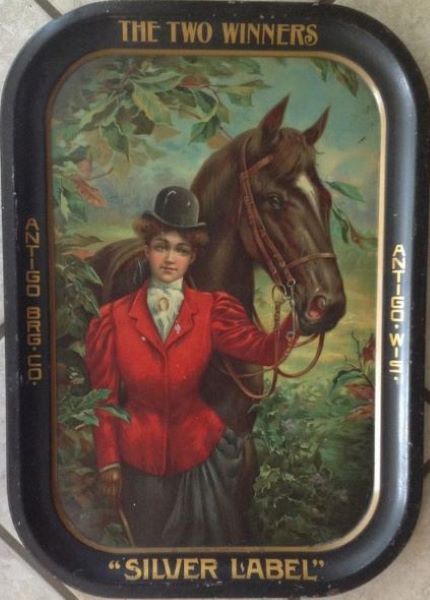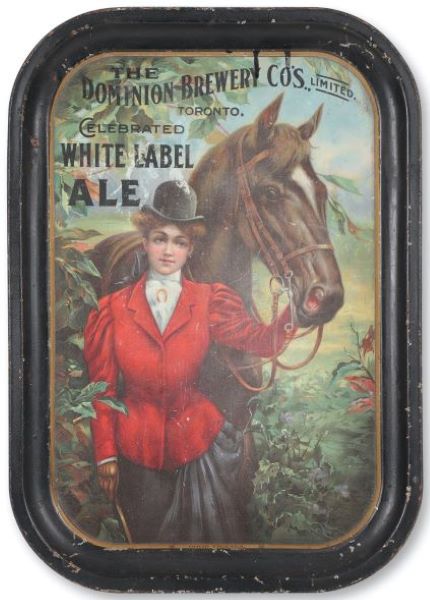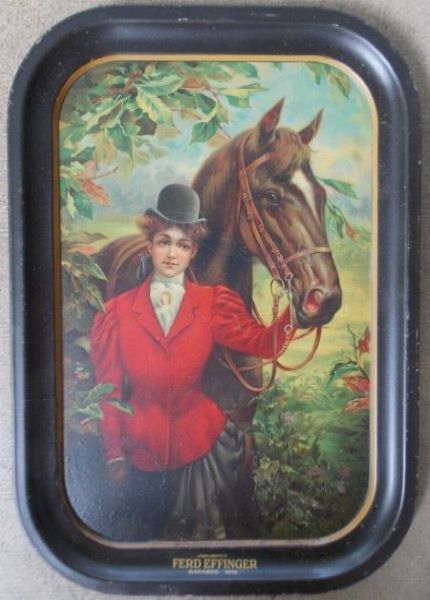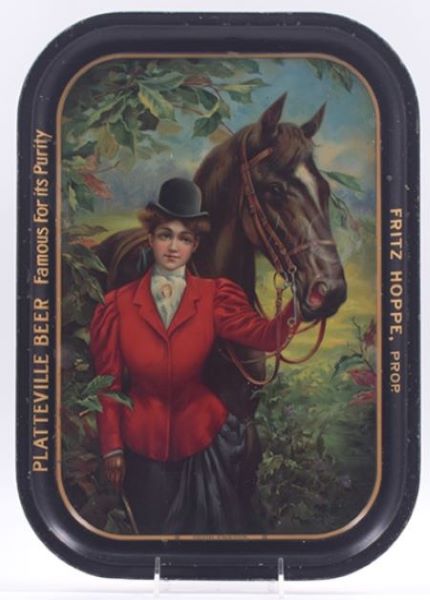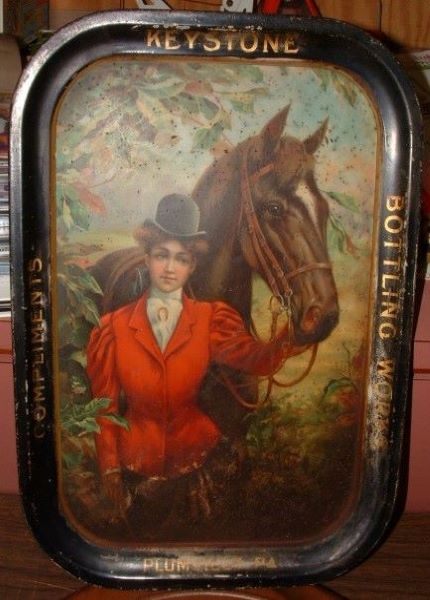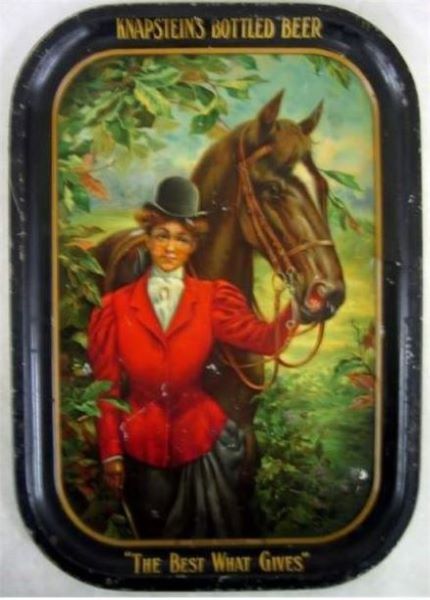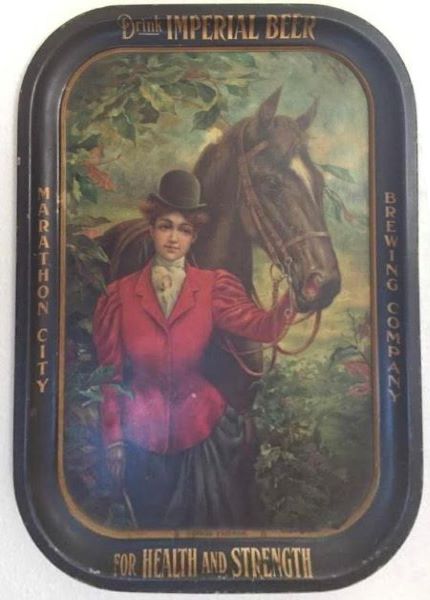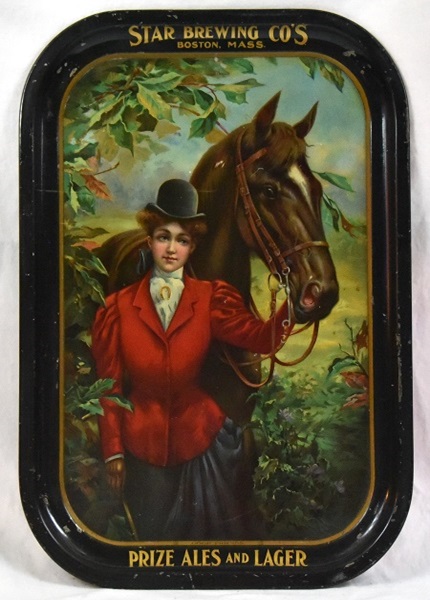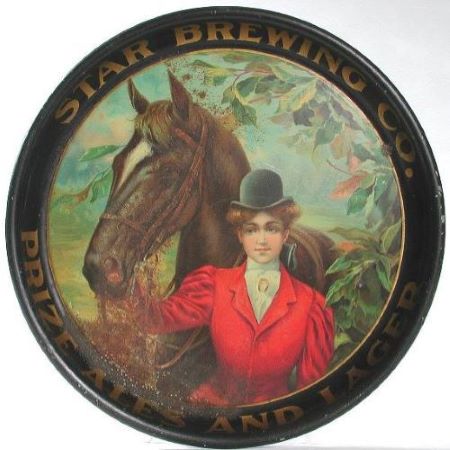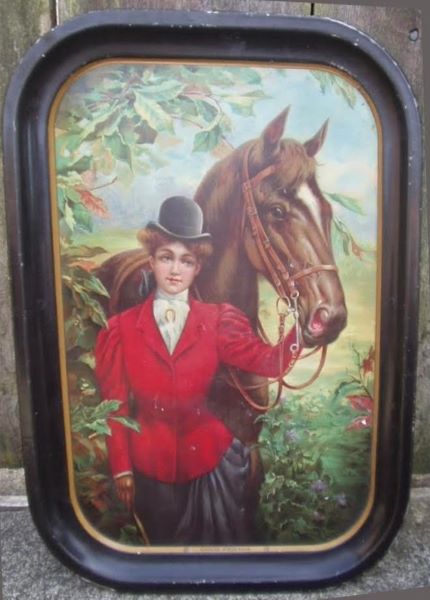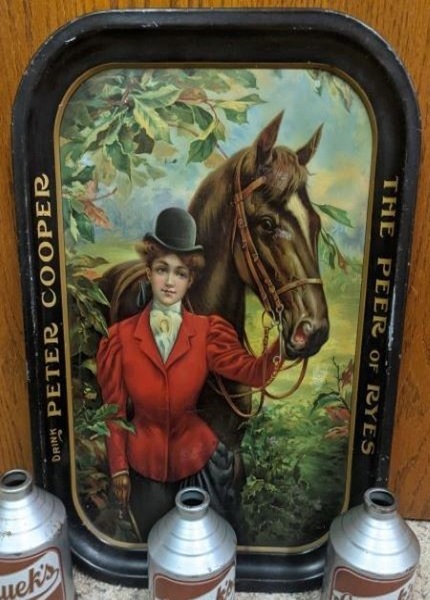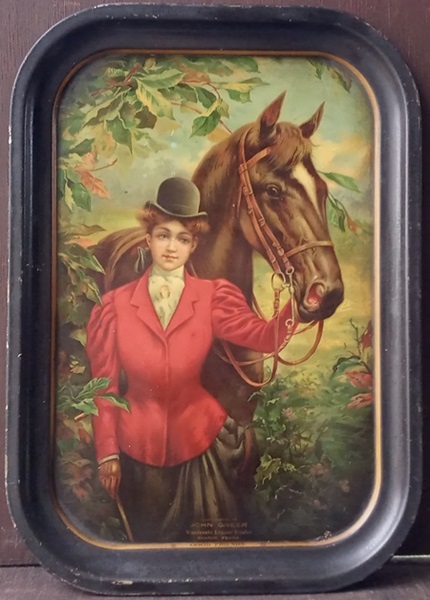The 'Stock' Exchange
The Meek Co.: No. 70 "Good Friends"
The Meek Co.: No. 70 "Good Friends"
Date: 1906 - 1910
Size: 12.25" x 17.25" & 13"
Type: Plate & Pie
Scarcity: Uncommon
Value: $$$ to $$$$
Condition & Brewer Dependent
Size: 12.25" x 17.25" & 13"
Type: Plate & Pie
Scarcity: Uncommon
Value: $$$ to $$$$
Condition & Brewer Dependent
Confirmed Brewer used Stock Trays
Non-Beer Related & Non-Tray Uses


General Comments
Horses and women appear numerous times on pre-pro Tuscarora/M&B/Meek/AAW stock trays as well as non-stock trays. We have not encountered any versions of this design with an artist’s signature like some of the later ones and have been unable to find any painting that this design might have been based on. There is too little here for any sort of literary identification. The woman’s outfit, a red jacket and bowler hat do suggest that fox hunting is the context for this design.
Fox hunting has a long history in a number of European countries dating back to at least medieval times, but in America we typically associate it with England where the earliest known attempt to hunt a fox with hounds was in Norfolk, England, in 1534, where farmers began chasing foxes down with their dogs for the purpose of pest control. The last wolf in England was killed in the early 16th century during the reign of Henry VII, leaving the English fox with no threat from larger predators. The first use of packs specifically trained to hunt foxes was in the late 1600's, with the oldest fox hunt being, probably, the Bilsdale in Yorkshire. American fox hunting traditions developed from English traditions which had developed detailed rules and procedures including attire of the hunters, particularly around the “colors” each participant was permitted to wear. The red jacket is still most commonly associated with fox hunting today.
The bowler hat, also known as a billycock, bob hat, or derby (United States), is a hard felt hat with a rounded crown, originally created by the London hat-makers Thomas and William Bowler in 1849. It has traditionally been worn with semi-formal and informal attire. The bowler, a protective and durable hat style, was popular with the British, Irish, and American working classes during the second half of the 19th century, and later with the middle and upper classes in the United Kingdom, Ireland, and the east coast United States. It is believed to have been commissioned by a customer to design a close-fitting, low-crowned hat to protect gamekeepers from low-hanging branches while on horseback at Holkham Hall, the estate of Thomas Coke, 1st Earl of Leicester in Norfolk.
Sahling does identify this design in his workbook with an entry for “Good Friends: stock oblong tray" in May 1906. As noted below, Star Brewery of Boston used this design in both an oblong and concave pie version; one of the few examples where an advertiser used two different size/shape versions of the same design.
Size & Shape
No. 70 comes in two tray size/shapes—large oblongs and 13” concave pies. The oblongs are far more prevalent. In fact, all of the concave pies we’ve encountered have been from Star Brewing of Boston, MA* who had previously used an oblong version causing us to wonder if they specially requested this design several years later after Meek had pulled it out of production. Interestingly, the design on the pie version is a mirror image, with the lady on the right and the horse on the left (opposite of the original oblong version). All examples we’ve encountered have black rims (in both the oblong and pie versions), with gold text on the rim. Dominion is an exception, using black text on the face of the tray. We have not encountered sign or tip tray versions of this design.
*We know that the concave pie version for Star Brewery is for the Boston based brewery because it includes the same phrase “Prize Ales and Lagers” that appears on the oblong version, which does include “Boston, Mass.” text on the rim.
Hager & Price
Hager does discuss this design when he presents a concave pie version in the article noting it does not have a title or stock number and that there are other later Meek stock trays without a number. The image he includes is too small and unclear to see whether it is Star Brewing. He also notes that the pie version is the mirror image of the oblong version, which he includes in his catalog.
Every example we’ve encountered that isn’t a stock sample, save one (a department store), are either breweries, bottlers or distilleries/liquor dealers. Perhaps there is some allusion to fast horses and fast women going on here? In any case, the stock samples and the department store prices are better than expected, but unremarkable. Distilleries and liquor dealers fair a little better, but the best prices are for breweries. Still, these are not much better than average.
Horses and women appear numerous times on pre-pro Tuscarora/M&B/Meek/AAW stock trays as well as non-stock trays. We have not encountered any versions of this design with an artist’s signature like some of the later ones and have been unable to find any painting that this design might have been based on. There is too little here for any sort of literary identification. The woman’s outfit, a red jacket and bowler hat do suggest that fox hunting is the context for this design.
Fox hunting has a long history in a number of European countries dating back to at least medieval times, but in America we typically associate it with England where the earliest known attempt to hunt a fox with hounds was in Norfolk, England, in 1534, where farmers began chasing foxes down with their dogs for the purpose of pest control. The last wolf in England was killed in the early 16th century during the reign of Henry VII, leaving the English fox with no threat from larger predators. The first use of packs specifically trained to hunt foxes was in the late 1600's, with the oldest fox hunt being, probably, the Bilsdale in Yorkshire. American fox hunting traditions developed from English traditions which had developed detailed rules and procedures including attire of the hunters, particularly around the “colors” each participant was permitted to wear. The red jacket is still most commonly associated with fox hunting today.
The bowler hat, also known as a billycock, bob hat, or derby (United States), is a hard felt hat with a rounded crown, originally created by the London hat-makers Thomas and William Bowler in 1849. It has traditionally been worn with semi-formal and informal attire. The bowler, a protective and durable hat style, was popular with the British, Irish, and American working classes during the second half of the 19th century, and later with the middle and upper classes in the United Kingdom, Ireland, and the east coast United States. It is believed to have been commissioned by a customer to design a close-fitting, low-crowned hat to protect gamekeepers from low-hanging branches while on horseback at Holkham Hall, the estate of Thomas Coke, 1st Earl of Leicester in Norfolk.
Sahling does identify this design in his workbook with an entry for “Good Friends: stock oblong tray" in May 1906. As noted below, Star Brewery of Boston used this design in both an oblong and concave pie version; one of the few examples where an advertiser used two different size/shape versions of the same design.
Size & Shape
No. 70 comes in two tray size/shapes—large oblongs and 13” concave pies. The oblongs are far more prevalent. In fact, all of the concave pies we’ve encountered have been from Star Brewing of Boston, MA* who had previously used an oblong version causing us to wonder if they specially requested this design several years later after Meek had pulled it out of production. Interestingly, the design on the pie version is a mirror image, with the lady on the right and the horse on the left (opposite of the original oblong version). All examples we’ve encountered have black rims (in both the oblong and pie versions), with gold text on the rim. Dominion is an exception, using black text on the face of the tray. We have not encountered sign or tip tray versions of this design.
*We know that the concave pie version for Star Brewery is for the Boston based brewery because it includes the same phrase “Prize Ales and Lagers” that appears on the oblong version, which does include “Boston, Mass.” text on the rim.
Hager & Price
Hager does discuss this design when he presents a concave pie version in the article noting it does not have a title or stock number and that there are other later Meek stock trays without a number. The image he includes is too small and unclear to see whether it is Star Brewing. He also notes that the pie version is the mirror image of the oblong version, which he includes in his catalog.
Every example we’ve encountered that isn’t a stock sample, save one (a department store), are either breweries, bottlers or distilleries/liquor dealers. Perhaps there is some allusion to fast horses and fast women going on here? In any case, the stock samples and the department store prices are better than expected, but unremarkable. Distilleries and liquor dealers fair a little better, but the best prices are for breweries. Still, these are not much better than average.
Click the Picture to Return to Meek & Beach Stock Catalog Page
